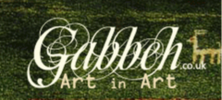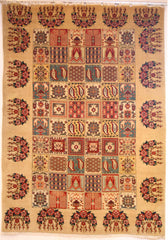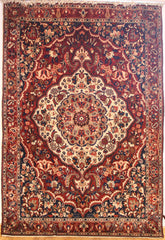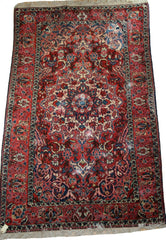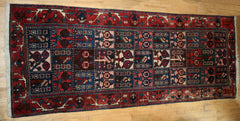Our Bakhtiari Collection
Rugs and other weavings associated with the Bakhtiari tribe fall into two groups, the first which can be described as ‘tribal’ and the second as ‘workshop’. The Bakhtiari, like many of the other great tribal groups of Persia, were formed into a Confederation in 1867 under the leadership of Ilkhan (supreme khan or leader); the particular Bakhtiari sub-tribe from the Ilkhans, the Zarasavand, were already very wealthy by this time, owning large amounts of the Chahar Mahall Valley to the east of Zagros Mountains and also great areas to the west of the range around the town of Shushtar.
The ‘tribal’ weaving of the Bakhtiari consist not only of large and extremely ornate saddle-bags and other similar woven containers but also superb rugs woven on wool foundations, some of them very large; compared to workshop rugs, these wool-based pieces are rare. Workshop rugs, although also often of magnificent quality and sometimes huge, can be distinguished from the ‘tribal’ pieces by the fact that they have cotton foundations. These were made in workshops of various sizes in the hundreds of villages in the Chahar Mahall valley owned by the Great Khans of the Bakhtiari, as well as in towns in the same Shahr-e-Kord and Shalamzar, which they also owned. In the first part of the twentieth century, when oil was struck on Bakhtiari land and the Great Khans owned a share of Persia’s oil revenues, their enormous wealth enabled them to ensure that only the finest materials were used for their rugs. Many such pieces bear inscriptions stating that were woven to the order of particular Khan, all of whom built huge mansions and palaces throughout the Chahar Mahall and elsewhere in the late nineteenth and early twentieth century.
A number of well-known designs are associated with Bakhtiari, including the so-called ‘garden’ or ‘garden-tile’ pattern of rectangles containing different motifs arranged all over the field, rugs with trees and flowering branches. Bakhtiari rugs, whether tribal or workshop, are dyed entirely with vegetable colours and they are among the most splendid and vivid of all nineteenth – and early twentieth- century Persian weavings. The Turkish knot is always used.




